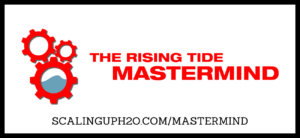 By highlighting cost savings, clients can see how efficient water treatment impacts their bottom line.
By highlighting cost savings, clients can see how efficient water treatment impacts their bottom line.
Sustainability isn’t just a trendy term—it’s about implementing practical practices that protect our planet for current and future generations. By adopting sustainable strategies, we can conserve resources, cut costs, and create lasting benefits for both the environment and our client’s businesses. In our latest episode of the Scaling UP! H2O Podcast, we had the privilege of speaking with James Courtney, CWT, LEED AP of CSC Technologies an advocate for water sustainability, who shared actionable insights on how water professionals can effectively embrace sustainability while adding value to their clients.
Meet James Courtney: A Champion for Sustainability
In our enlightening conversation, James shared his journey in the water industry and emphasized the vital role that water professionals play in promoting sustainability. He stated, “We help our customers by saving them money on water, electricity, and fuel.” This highlights how our work not only benefits the environment but also leads to significant financial savings for our clients.
Sustainability: More Than Just a Buzzword
Sustainability means optimizing our resources. As James noted, “We operate in this space where we are directly responsible for the sustainability of our customers.” Water treaters have a unique opportunity to minimize their clients’ carbon footprints while improving efficiency. Whether it’s running boilers without scale, optimizing cooling towers, or maximizing cycles of conductivity, every action contributes to a greener future.
James also cautioned against greenwashing, reminding us that not all practices labeled as “green” deliver real benefits. We must be vigilant and ensure that our sustainability efforts
Educating and Empowering Clients
Understanding water and energy usage is essential for effective water management. James encourages water professionals to educate their clients about their consumption patterns. “Clients often don’t realize that overusing chemicals or wasting water is a problem,” he explained. By illustrating the cost savings—like reducing their electricity bills or fuel costs—clients can connect the dots between efficient water treatment and their bottom line.
Harnessing Data
One of James’s most compelling stories was about using smart meters to identify inefficiencies. He shared, “Meters give you information; information gives you the opportunity to find solutions to problems you didn’t even know you had.” In one instance, a client’s building was using half a million gallons of water due to a blocked condensate receiver. The installation of a meter enabled the team to identify the issue and prevent unnecessary water loss, ultimately leading to significant cost savings for the client.
James’s team also tackled a fascinating case with two identical LEED Platinum buildings. Even though they were built exactly the same, one consumed significantly more power. By analyzing minute-by-minute energy data, they pinpointed the problem, leading to solutions that not only enhanced efficiency but also inspired other buildings in the community to adopt similar practices.
The Impact of Visibility
James highlighted an intriguing study involving a housing development where identical homes were built. In half of these homes, energy meters were placed indoors, allowing residents to see their energy usage, while the other half had meters located outdoors. The results were striking: “The houses with visible indoor meters used less energy simply because people could see it,” James explained. Residents began to turn energy monitoring into a game, challenging themselves to reduce their consumption.
This simple shift towards visibility in daily energy use not only heightened awareness among residents but also nurtured a culture of energy-saving habits. As James aptly put it, “What gets measured gets managed.” Engaging clients in enjoyable and measurable ways can significantly drive sustainability efforts.
Final Thoughts
James’s insights remind us of the significant role water professionals play in fostering a sustainable future. By leveraging data and educating our clients, we can create meaningful change that benefits both our communities and the environment. Together, let’s continue to explore the importance of sustainability practices that protect our generation and the ones to come.
Thank you for being part of the Scaling UP! H2O community. Together, let’s continue to educate ourselves and each other on the importance of sustainability practices that benefit both our generation and those to come.
Stay curious, stay informed, and keep scaling up your knowledge!
Timestamps
01:28 – Trace Blackmore shares what he is thankful for, and extends gratitude to the listeners and to AWT for the 2024 Innovation Award, and shares his family’s Thanksgiving traditions
15:18 – Interview with James Courtney, CWT
58:00 – Upcoming Events for Water Treatment Professionals
01:01:05 – Drop by Drop with James McDonald
Connect with James Courtney
Phone: +1 443 878 2407
Email: james@csctech2o.com
Website: https://www.csctech2o.com/
LinkedIn: https://www.linkedin.com/in/james-courtney-cwt-leed-ap-379a6877/
Read or Download James Courtney’s Press Release HERE
Guest Resources Mentioned
Check if your seafood is sustainable here
Check your water footprint here
Difficult Conversations: How to Discuss What Matters Most by Douglas Stone
I Said This You Heard That by Kathleen Edelman
LEED AP O+M Class
More than half of energy use in homes is for heating and air conditioning article
The Last Optimist by Mark Mills (Podcast)
The United States uses a mix of energy sources article
Scaling UP! H2O Resources Mentioned
Alton Brown’s turkey recipe, Romancing The Bird
Donate To Our 6K World Vision Team
Learn how to make your own 6K World Vision Team
Industrial Water Week Resources
The Rising Tide Mastermind
Scaling UP! H2O Academy video courses
Submit a Show Idea
AWT (Association of Water Technologies)
386 Industrial Water Week 2024: Boiler Tuesday
004 It’s Not Easy Being Green!
325 Rising Together: Conquering Challenges through Collective Support
Drop By Drop with James
In today’s episode, we’re thinking about control ranges. There are a few trains of thought on control ranges. Which tests and readings really need a control range applied to them? How wide or narrow should the control range be? It’s something one should consider carefully. I have seen control ranges applied to every test parameter for a makeup, such as city water, that the user had absolutely no control over. Are these control ranges really necessary? Sometimes, they are, especially if the makeup source is susceptible to changes in water quality, such as total hardness, which can impact downstream softener performance. I’ve also seen control ranges so large a bus could slide through them sideways. What good is such a wide control range doing for the water system? Nothing was actually being controlled. I’ve seen control ranges that were so unreasonably narrow that the parameters were almost ALWAYS out of range as well. What good does that serve? Is a better control system needed to meet these narrow ranges or is a wider control range more fitting instead? A lot of you out there use field service report programs that turn red, green, and sometimes yellow when a parameter is outside the control range. Not having good and proper control ranges can make that field service report’s color coding nearly useless because it is always too red or even too green and not actually reflecting the true stressed or controlled state of the system. Control ranges that are too tight may yield field service reports that are red all the time, which will lead to either the end user ignoring the colors or being annoyed by the report always looking red. Control ranges that are too broad may not show the true state of stress the system is under and lead to more problems down the road. Lastly, I’ve even seen reps be pressured by their customers to avoid red color coding as much as possible, leading to either uselessly wide control ranges or no control ranges at all. This can be a touchy subject, but your control ranges must be meaningful and useful. It may take some finesse to get everyone on the same side of the table on this but seeing a little red when appropriate TODAY beats dealing with the impact of a failed water system and wasted energy and water TOMORROW.
Events for Water Professionals
Check out our Scaling UP! H2O Events Calendar where we’ve listed every event Water Treaters should be aware of by clicking HERE.

